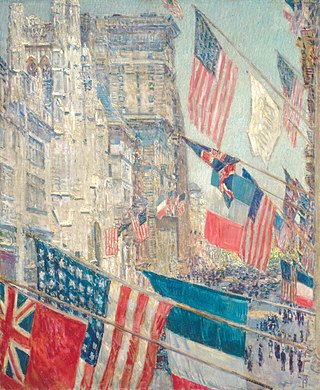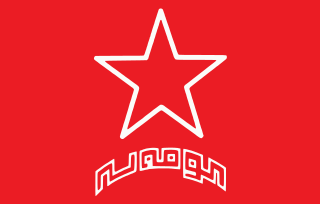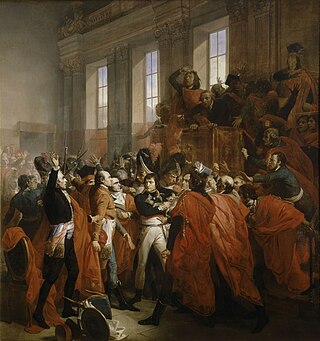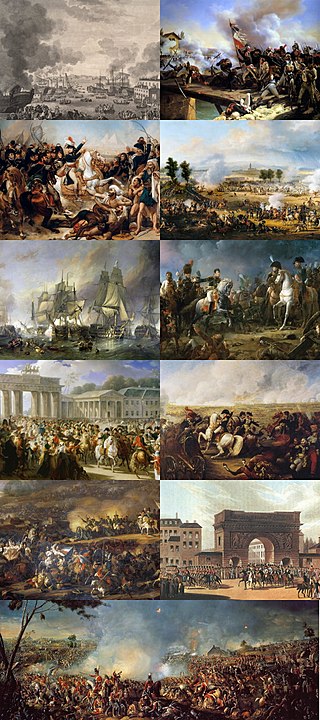Related Research Articles

War is an armed conflict between the armed forces of states, or between governmental forces and armed groups that are organized under a certain command structure and have the capacity to sustain military operations, or between such organized groups. It is generally characterized by extreme violence, destruction, and mortality, using regular or irregular military forces. Warfare refers to the common activities and characteristics of types of war, or of wars in general. Total war is warfare that is not restricted to purely legitimate military targets, and can result in massive civilian or other non-combatant suffering and casualties.

Asymmetric warfare is a type of war between belligerents whose relative military power, strategy or tactics differ significantly. This type of warfare often, but not necessarily, involves insurgents, terrorist groups, or resistance militias operating within territory mostly controlled by the superior force.

An alliance is a relationship among people, groups, or states that have joined together for mutual benefit or to achieve some common purpose, whether or not an explicit agreement has been worked out among them. Members of an alliance are called allies. Alliances form in many settings, including political alliances, military alliances, and business alliances. When the term is used in the context of war or armed struggle, such associations may also be called allied powers, especially when discussing World War I or World War II.
A coalition is formed when two or more people or groups temporarily work together to achieve a common goal. The term is most frequently used to denote a formation of power in political, military, or economical spaces.

A military alliance is a formal agreement between nations that specifies mutual obligations regarding national security. In the event a nation is attacked, members of the alliance are often obligated to come to their defense regardless if attacked directly. Military alliances can be classified into defense pacts, non-aggression pacts, and ententes. Alliances may be covert or public.

In political science, a proxy war is an armed conflict where at least one of the belligerents is directed or supported by an external third-party power. In the term proxy war, a belligerent with external support is the proxy; both belligerents in a proxy war can be considered proxies if both are receiving foreign military aid from a third party country. Acting either as a nation-state government or as a conventional force, a proxy belligerent acts in behalf of a third-party state sponsor.

Deterrence theory refers to the scholarship and practice of how threats of using force by one party can convince another party to refrain from initiating some other course of action. The topic gained increased prominence as a military strategy during the Cold War with regard to the use of nuclear weapons and is related to but distinct from the concept of mutual assured destruction, according to which a full-scale nuclear attack on a power with second-strike capability would devastate both parties. The central problem of deterrence revolves around how to credibly threaten military action or nuclear punishment on the adversary despite its costs to the deterrer. Deterrence in an international relations context is the application of deterrence theory to avoid conflict.
Decapitation is a military strategy aimed at removing the leadership or command and control of a hostile government or group.

A military exercise, training exercise, maneuver (manoeuvre), or war game is the employment of military resources in training for military operations. Military exercises are conducted to explore the effects of warfare or test tactics and strategies without actual combat. They also ensure the combat readiness of garrisoned or deployable forces prior to deployment from a home base.

The Komala Party of Iranian Kurdistan, commonly shortened to Komalah, is a social-democratic ethnic party of Kurds in Iran. Formerly with Marxist-Leninist and communist ties, the Komalah is a well established party with a history of more than five decades. The Komala party's headquarters are presently in the Kurdistan Region of Iraq. They have an armed wing that has a history of leading the Kurdish resistance. The Komalah was advocated for anti-imperialism and Kurdish self-determination.

OTR-21 Tochka is a Soviet tactical ballistic missile. Its GRAU designation is 9K79. Its NATO reporting name is the SS-21 Scarab. One missile is transported per 9P129 vehicle and raised prior to launch. It uses an inertial guidance system.
Chain ganging is a term in the field of international relations describing the elevated probability for interstate conflict or conflagration due to several states having joined in alliances or coalitions.

The Battle of Talikota, also known as that of Rakkasagi–Tangadagi, was a watershed battle fought between the Vijayanagara Empire and an alliance of the Deccan sultanates. The battle resulted in the defeat and death of Rama Raya, the de facto ruler of the Vijayanagara Empire, which led to the immediate collapse of the Vijayanagara polity and reconfigured South Indian and Deccan politics.

Unrestricted Warfare: Two Air Force Senior Colonels on Scenarios for War and the Operational Art in an Era of Globalization is a book on military strategy written in 1999 by two colonels in the People's Liberation Army (PLA), Qiao Liang (乔良) and Wang Xiangsui (王湘穗). Its primary concern is how a nation such as China can defeat a technologically superior opponent through a variety of means. Rather than focusing on direct military confrontation, this book instead examines a variety of other means such as political warfare. Such means include using legal tools and economic means as leverage over one's opponent and circumvent the need for direct military action.

The Islamic Revolutionary Guard Corps Navy is the naval warfare service of the Islamic Revolutionary Guard Corps founded in 1985, and one of the two maritime forces of Iran, parallel to the conventional Islamic Republic of Iran Navy. The IRGC has been designated as a terrorist organization by the governments of Bahrain, Saudi Arabia and the United States. IRGC's Navy has steadily improved its capabilities to support unconventional warfare and defend Iran's offshore facilities, coastlines, and islands in the Persian Gulf.

Study of the environmental impact of war focuses on the modernization of warfare and its increasing effects on the environment. Scorched earth methods have been used for much of recorded history. However, the methods of modern warfare cause far greater devastation on the environment. The progression of warfare from chemical weapons to nuclear weapons has increasingly created stress on ecosystems and the environment. Specific examples of the environmental impact of war include World War I, World War II, the Vietnam War, the Rwandan Civil War, the Kosovo War, the Gulf War, and the 2022 Russian invasion of Ukraine.

A coup d'état, or simply a coup, is typically an illegal and overt attempt by a military organization or other government elites to unseat an incumbent leadership. A self-coup is when a leader, having come to power through legal means, tries to stay in power through illegal means.
Hybrid warfare was defined by Frank Hoffman in 2007 as the emerging simultaneous use of multiple types of warfare by flexible and sophisticated adversaries who understand that successful conflict requires a variety of forms designed to fit the goals at the time. A US document on maritime strategy said "Conflicts are increasingly characterized by a hybrid blend of traditional and irregular tactics, decentralized planning and execution, and non-state actors using both simple and sophisticated technologies in innovative ways." While there is no clear, accepted definition, methods include political warfare and blend conventional warfare, irregular warfare, and cyberwarfare with other influencing methods, such as fake news, diplomacy, lawfare, regime change, and foreign electoral intervention. By combining kinetic operations with subversive efforts, the aggressor intends to avoid attribution or retribution. The concept of hybrid warfare has been criticized by a number of academics and practitioners, who say that it is vague and has disputed constitutive elements and historical distortions.

The Iran-Saudi Arabia proxy conflict, or the Iran-Saudi Arabia rivalry, is an ongoing struggle for influence in the Middle East and other regions of the Muslim world. The two countries have provided varying degrees of support to opposing sides in nearby conflicts, including the civil wars in Syria and Yemen; and disputes in Bahrain, Lebanon, Qatar, and Iraq. The struggle also extends to disputes or broader competition in other countries globally including in West, North and East Africa, South, Central, Southeast Asia, the Balkans, and the Caucasus.

The French Revolutionary and Napoleonic Wars, sometimes called the Great French War, were a series of conflicts between the French and several European monarchies between 1792 and 1815. They encompass first the French Revolutionary Wars against the newly declared French Republic and from 1803 onwards the Napoleonic Wars against First Consul and later Emperor Napoleon Bonaparte. They include the Coalition Wars as a subset: seven wars waged by various military alliances of great European powers, known as Coalitions, against Revolutionary France – later the First French Empire – and its allies between 1792 and 1815:
References
- ↑ Weitsman, Patricia A. (2010). "Wartime Alliances versus Coalition Warfare: How Institutional Structure Matters in the Multilateral Prosecution of Wars". Strategic Studies Quarterly. 4 (2): 113–138. ISSN 1936-1815. JSTOR 26269800.
- ↑ O’Connor, Steven; Piketty, Guillaume (2020). "Introduction – Foreign fighters and multinational armies: from civil conflicts to coalition wars, 1848–2015" (PDF). European Review of History: Revue européenne d'histoire. 27 (1–2): 1–11. doi:10.1080/13507486.2019.1709048. S2CID 216204960.
- ↑ Terraine, John (June 1989). "Lessons of coalition war: 1914 and 1939". The RUSI Journal. 134 (2): 57–62. doi:10.1080/03071848908445368.
- ↑ Schmitt, Olivier (2018). Allies that Count: Junior Partners in Coalition Warfare. Georgetown University Press. ISBN 978-1-62616-547-2.
- ↑ Treverton, Gregory F. (10 April 2019). "Ending Major Coalition Wars". Conflict Termination and Military Strategy. Routledge. pp. 89–108. doi:10.4324/9780429041495-6. ISBN 978-0-429-04149-5. S2CID 198021110.